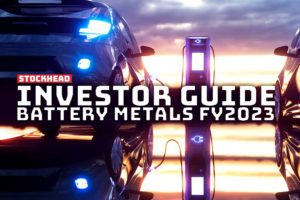- Former Pilbara Minerals boss Ken Brinsden is back as the non-exec chair of Canadian and soon to be ASX lithium explorer Patriot Battery Metals
- The lithium legend says analysts predicting a supply-led price crash have the market all wrong
- An US and North American electric vehicle supply chain reluctantly reliant on China will drive the development of local mines like Patriot’s Corvette discovery in Quebec, Brinsden says
With the big pegmatites of the WA outback mapped, drilled, mined and turned into the world’s largest supplier of lithium for the electric vehicle revolution, Australian miners and geologists have dutifully spread their wings abroad to solve a global problem.
Where will we find the extraordinary amounts of lithium required to fuel the shift from dirty, oil-guzzling internal combustion engines to electric vehicles backed by renewable energy and storage?
In the face of a surge in demand, supply has been slow to catch up. Prices have soared from a margin-treading US$500/t for 6% lithium concentrate to almost US$8000/t on some spot estimates in just two years.
Chemicals sold directly to battery makers in China are circling an eyebrow-raising US$80,000/t, a position where many analysts say the upside could be limited.
It has seen a large scale prospectors’ camp of expats converge on the James Bay region in a remote part of the Canadian Territory of Quebec, where miners who turned Australia’s spodumene wealth into rivers of gold are hoping to repeat the feat almost 18,000km away.
Among them is one of the modern lithium industry’s pioneers Ken Brinsden, famed for driving the development the Battery Materials Exchange auction platform Pilbara Minerals (ASX:PLS) to uncover the true market value of Australian lithium concentrate.
Fresh off his retirement at PLS, which took just eight years to ride the lithium sector’s emergence from a penny stock with an obscure tantalum project in the sparsely-populated iron ore rich region into a major source of raw materials for the EV industry worth $15 billion, he is back on the ASX radar.
This time it is as non-executive chairman at Patriot Battery Metals (ASX:PMT), a Canadian-listed lithium explorer planning to raise $4.2 million to dual-list on the Australian bourse next month.
It owns 214sqkm of prime spod exploration ground including the Corvette discovery, a 50km trend littered with spodumene outcrop it hopes could be the next major North American lithium discovery.
Located just down the road from, among others, Allkem’s (ASX:AKE) James Bay deposit — 37.2Mt at 1.3% Li2O — drilling results have included hits of around 1% Li2O over intercepts greater than 100m.
We caught up with Ken Brinsden to see why he thinks the big investment banks (cough, Goldman Sachs, cough) have the lithium market all wrong, the drive to create a North American battery supply chain and why the ASX was the right place for Patriot Battery Metals to be.
Oh, and we got a cheeky one in on the impending friendly rivalry with fellow ASX listee Patriot Lithium (ASX:PAT).
Before I get on to Patriot specifically I’ve got to ask you we’ve had some pretty turbulent times on the ASX for lithium stocks over the last couple of weeks, particularly driven by a little bit of news out of China and some broker notes. Do you see these calls that prices have hit a top or prices could drop significantly with oversupply as just too early?
“Yeah, absolutely. There’s a lot of ill-informed commentary in lithium markets. And it’s kind of a shame because, in some respects the investing public put faith in especially the big banks, but the truth is, the big banks are not close to the lithium market, really at all. And as a result, a lot of their commentary is just fundamentally flawed.
“Most of it comes from the perspective that they want to shape the market based on historical paradigms in lithium raw materials and that just does not work for a market that’s growing as quickly on the demand side as it is for lithium, and for that matter the difficulties in growing supply.
“If you were shaping your commentary about lithium markets in the 2020s based on the 2000s or even to a certain extent the first half of the 2010s you’re fundamentally misreading the market, it has completely changed.
“And the growth that’s underway means there’s a whole heap of new paradigms that describe the shape of the market and that’s the phase that we’re going through now. They mostly get it wrong on the supply side.
“Analysts want to sort of imply that supply will come easily but nothing could be further from the truth. Lithium raw material supply is really difficult to develop and will be for quite some time because the mines are measured in five to seven to 10-year increments for development, and that’s just not the speed that’s required for the demand side growth that’s going on.”
Is there any real comparison historically that you can give to explain the growth in demand for lithium that we’ve seen over the last five years?
“It’s a little bit of a dangerous analogy, because it’s a completely different mineral species, but a good example of resource growth that changed the shape of a mineral market is what happened in iron ore between 2006 and 2015, there was a decent decade of demand growth motivated principally by China at that time.
“Iron ore seaborne supply grew about two, three times and the price in the early part of the 2000s was defined by cost support at US$25-30 a tonne because that’s what the Pilbara operations cost. But as the market grew, and the demand growth from China came on, a whole heap of other iron ore projects came to market that completely restructured the cost curve basically built out the right-hand side of the cost curve.
“And now there’s price support in iron ore between US$70-100 a tonne, obviously very, very different to historical norms. So when I think about what’s happening in lithium raw materials, I think of that as being not a bad analogy to describe what’s happening in lithium raw materials, but it’s even more extreme because the market has to grow 10 times between 2020 and 2030.
“And as a result, a whole heap of projects are going to come to market and in fact some are already that are much higher cost than historical norms in lithium raw materials, and that’s why there will be a completely restructured cost curve and therefore price inputs.”
The idea of demand growing 10 times in a decade is mind-boggling.
“Well that’s one of the analogies and the second one, in this respect is very different to iron ore. Lithium is fundamentally a specialty chemical, it’s not a commodity, at least not yet.
“The quality paradigms that have to be delivered to support the battery industry are very, very high. And actually higher than historical norms in lithium raw materials as well.
“So that’s redefining a market that would have otherwise just required an average specification to support greases and ceramics and some of the some of the other historical uses for lithium raw materials.
“So those two things are motivating a completely different cost base, supply growth in new projects that are much more expensive than historical norms. And the second thing is the very, very high quality threshold that’s driven by the battery industry, which is where all the demand is coming from.”
Is that something people don’t really understand? I’ve heard anecdotal stories of how difficult it’s been to get the quality up to spec at, say, the Australian hydroxide plants.
“That’s exactly right. That’s the challenge that the industry has to meet and it’s typically going to be solved with cost, additional cost to purify the materials to be suitable to go into a battery. And that’s why some analysts, not all, but some analysts and especially some of the big banks with recent reports are completely missing the new shape of the industry.”
Just going back to the decision to retire at Pilbara minerals, it was quite a journey from a penny stock to a $15 billion market cap. How extreme was that journey from getting in, purchasing Pilgangoora for not a lot at all, to seeing the market do what it’s done in the last year or so?
“It’s fair to say it was an incredible journey. But the extremes that you’ve described there are in part one of the reasons why I felt like my time had come after a very, very intense period of work.
“Now the company being a very large company means that it was time for a break. So that was my personal perspective.
“But then I think about it from (Pilbara Minerals’) point of view as well … for who am I to say I know all the answers in the lithium world? I don’t mind the idea that there is a new perspective and a fresh set of eyes looking at the assets and saying, well, look, what can we do with them now?
“And for those reasons, I think my time had come and to the board’s credit they were really supportive of helping with that change.
“Especially with Dale Henderson taking over, it feels like it’s gone incredibly smoothly. Dale is a very capable and energetic leader for the company so I feel like the circumstances that arose there for all of that change, were about as good as you could hope for.”
And then the decision then, to get involved with a company in Canada in this sort of emerging lithium area in Quebec. What’s the potential there going from working in an area which is now the largest lithium producer in the world in WA and the Pilbara to a place where it’s at a much earlier stage?
“It’s fair to say getting involved in Patriot came as a bit of a surprise to me as well, because I wasn’t intending to take anything on and I was going to have a decent break. But the project was that good I couldn’t let it go. I feel like it’s one of the more important discoveries that’s been made in lithium raw materials in the last decade or so.
“For all those reasons, I felt like I should not let it pass up. Hence putting the guernsey back on and getting into it.
“As to Canada versus Western Australia, well, I think it’s fair to say that they’re both really good mining jurisdictions and there’s a lot to like about Quebec, where the Corvette discovery is and their support of the critical minerals industry. That’s the first thing and the second thing is the North American market is grossly underserved for raw materials.
“They’ve actually got a really big problem to solve for their raw materials supply chain and that’s another reason why I really like Canada and Quebec as a jurisdiction to support the North American market over time. There’s a lot of EV plants being built in the US, there’s a lot of cell-making capacity being built in the US, but there is very little going on in the way of all materials and value-added chemicals.
“They need a lot more raw material and I feel like the Corvette discovery is going to be part of that solution over time. That was another area of attraction.
“Another reason why this discovery is so important too is the US does not want to be overly reliant on the North Asia supply chain, but in particular China. The only way they can solve that is by developing these alternate supply chains and again, that’s why I think Corvette’s going to be such an important discovery for that North American market.”
In that we have seen, I guess, more in the United States and in Canada, a bit of potential NIMBYism popping up, people raising objections to minds in their backyards in North America, does that make the challenge even harder where you are in the US and Canada?
“I think of that as being much more a US problem than it is a Canada problem, and especially not Quebec. So Quebec is actually a bit like Western Australia, it’s remote, our resources are remote and mineralisation is remote, but not so remote to the mine that it can’t still be a useful solution in the supply chain. In the US unfortunately the reverse is true.
“The mineralisation, not always, but might be close to existing communities and hence the reticence to develop or even redevelop old mines. It’s particularly prevalent in the last decade or so as I’ve observed. I think their behavior is starting to change and they’re starting to understand the enormity of the challenge they have in raw materials supply.
“So it might very well be the case that you see a change in their behavior. But as it stands today, it’s tough going getting a mine up and running in the US, and not such a big issue in Quebec.
Just on the the area there, you’ve got James Bay, Whabouchi, Moblan, all those deposits down the road – does it put you in a pretty good position to make a discovery especially since there’s potentially some infrastructure that will be going in place over the next few years?
“It’s one of the really important considerations in the development of a hard rock mine, complementary infrastructure and it all being accessible. And that is absolutely the case for the Corvette discovery. Lots of complementary infrastructure, all weather roads and hydropower, very cheap power, literally just up the road it’s only 15km away.
“All those things contribute to the development story and as you quite rightly pointed out, there is a bit of a sort of a lithium raw materials community, I guess, starting to develop in Quebec especially because the old greenstone belts have been proven to host some mineralisation.
“There’s some better than others, but nonetheless some mineralisation that’s going to be an important part of the North American supply chain. Stating it plainly, it’s all required. Bringing these mines to market to serve a market that’s going to grow 10 times is absolutely required and it’s required as soon as possible.
“Pricing is going to sit at extreme levels until there is a reasonable supply response and as much as there will be a supply response, it won’t happen quickly, in which case, I don’t think we need to fear a price crash anytime soon.”
You’ve had a little bit of exploration success already at Corvette first with the discovery of the trend five years ago and then with some recent drill results. How soon and how much work do you think needs to go in to turn that into a resource?
“We’re well down that path. We expect to announce the maiden resource in March next year and it’s shaping up to be a good one which shouldn’t come as a surprise, because the geology the way I describe it is to say it’s a really fertile system. Very large pegmatite hosts, and then very complementary or high grade spodumene within.
“So for all those reasons we’re confident in it ultimately being a pretty big resource and as much as that’ll be an important maiden resource, our expectation is that the whole project will grow from there.
“There’s a significant body of exploration work and ground to cover based on what we can see in outcrop in our region. So for all those reasons, we’re really excited about the potential in the project and ultimately pushing to get the Corvette project to the front of the queue for development as a function of its scale, and being in a great location.”
What informed the decision to pursue the ASX listing when you already have the listing in Canada?
“There is two distinct markets there. In Canada, they historically at least have been a bit jaded about the lithium world because there hasn’t really been any material success in Canada as yet with respect to particularly mine development and successful mining operations; at least not in the way that it has been in Australia.
“Pilbara minerals being obviously a notable example, a company that got through the exploration phase, development, and now making significant cash flow. For that reason there is a differential in valuation between the two exchanges. In short, we would say the ASX is better valuing lithium raw materials projects as compared to the TSX.
“So as much as we’re a Canadian company a lot of shareholders are already in Australia. So there’s logic in pursuing the ASX listing, which is not too far away now.”
I guess a quirk of it is that your listing is two days after another Patriot Lithium. Have you got any bets with (Patriot Lithium chair and former Tianqi Australia boss) Phil Thick about who’s going to come out on top on your opening day?
“That’s a really good question Josh, I’ll have to pursue Phil and ask the question. He’s a good guy. I don’t know where their name came from, that’s an interesting coincidence, that’s for sure.”
No copyright claims coming?
“No, that’s OK (muffled laughter), we’ll survive.”
You might be interested in












